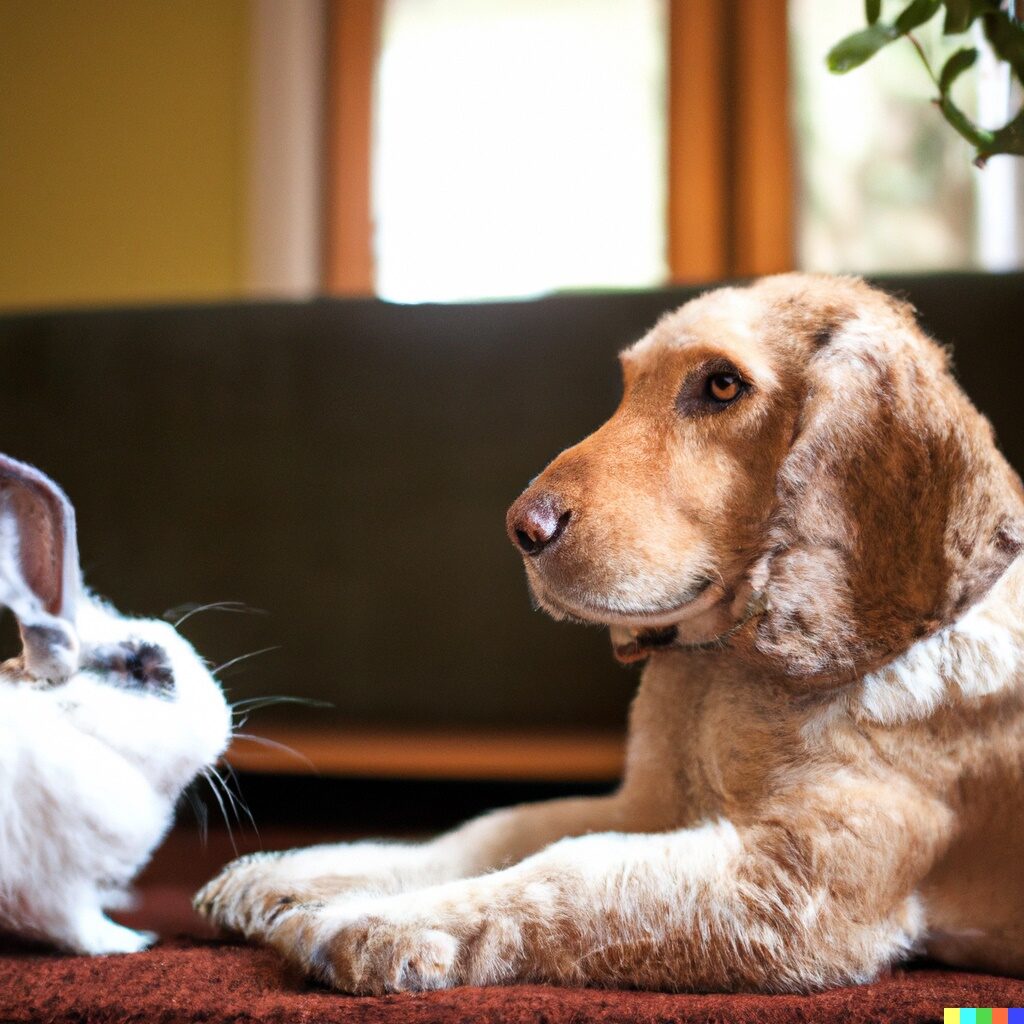Yes, a rabbit and dog can live together but getting them to live together is a slow and gradual process getting them to bond with one another. Are you considering introducing a furry friend to your family? If so, then the question on everyone’s lips is: Can rabbits and dogs live together? We all know that cats and dogs have been living side-by-side for centuries, but what about rabbits and dogs? Let’s take a closer look at the pros and cons of these two animals cohabiting in harmony.
Can Rabbits And Dogs Live Together?
Rabbits and Dogs – A Comparison
Rabbits and dogs are two popular companion animals found in households around the world. While they may share some basic similarities, these two small mammals have a number of differences that make them unique from one another.
For starters, rabbits and dogs vary widely when it comes to size and shape. Rabbits come in all shapes and sizes depending on their breed; many domestic rabbits remain fairly small while others can grow up to 10 pounds or more! Domesticated dogs, on the other hand, typically weigh between 15 and 100 pounds, depending on the breed. Furthermore, their body types diverge greatly: while a rabbit’s body is compact with short legs and ears pointing upwards, a dog has longer legs with an elongated torso featuring floppy ears that hang down alongside its face.
Also Read: Can rabbits run?
Another major difference between these two animals lies in their natural habitats: rabbits prefer living outdoors with plenty of open space, whereas most domesticated dogs are comfortable indoors as well as outside due to centuries of selective breeding for companionship purposes. Additionally, when it comes to exercise needs, both animals differ significantly: rabbits require daily outdoor access for running around or playing in order to satisfy their instinctual need for movement, whereas most breeds of dogs require regular walks or playtime so they may get adequate physical activity each day.
Best Practices for Introducing a Rabbit to Your Dog
Introducing a rabbit to your dog is an important process that requires special care and attention. By following best practices, you can ensure both animals are comfortable in their new environment and have the best chance at forming a safe, happy bond.
First off, it’s important to give the bunny its own space away from the dog. This could be anything from its own room or designated area of your home to a completely separate crate or cage for when you’re not around. Having this space will provide security for the rabbit and allow them time away from your pup if they need some alone time. It also gives them somewhere familiar and secure where they can eat without being disturbed by loud noises or overly excited dogs!
Once your pet rabbits has settled into their own spot, start getting them used to each other with slow introductions — always supervised of course! Start by allowing them to sniff each other through closed doors until there is no sign of stress on either side; then move onto letting them interact while separated by a barrier (like baby gates). If all goes well, let your pup take short walks near their new friend while keeping both on-leash so you always maintain control over any situation that may arise between them. Finally, once trust has been established between both parties:
• Offer treats like carrots as rewards whenever appropriate behavior occurs
• Give plenty of verbal praise during interactions
• Always supervise playtime sessions together
Tips on Training Your Dog to Respect Your Rabbit
Training your dog to respect your rabbit can be a difficult process, but it is definitely possible! The key to success lies in understanding the relationship between dogs and rabbits, as well as being able to read canine body language. With patience and consistency you can successfully teach your pup how to coexist peacefully with their fluffy companion. Here are some tips for training your pooch:
- Familiarize Your Dog With the Rabbit. Take things slow by introducing them on neutral ground, such as a park or outdoor area that neither animal has been previously exposed too. Allow both animals enough time to get accustomed to one another’s scent before bringing them together.
- Set Boundaries From the Beginning. Make sure that when they first meet, there’s an appropriate distance between them – do not allow physical contact until they are completely comfortable with each other’s presence. Do not leave either animal alone while in close proximity of one another until trust has been built over time.
Once both animals become more familiar with each other’s presence, start rewarding positive behaviors like calmness and non-aggression from your pup whenever he’s around the rabbit. Give verbal praise or treats when these behaviors are exhibited so that he knows what behavior is expected of him when interacting with his small furry friend. Likewise if negative behaviors occur (such as barking, chasing or lunging), immediately correct these actions by taking away rewards and providing a firm “no” or “stop” command followed by removing him from the situation and returning at a later date once he has calmed down again.
With patience and plenty of practice – you will soon have two happy companions living harmoniously side-by-side!
FAQS
Will my dog hurt my rabbit?
It is difficult to predict how individual animals will interact. However, it is generally advisable to keep cats and dogs away from rabbits as they can both potentially harm the rabbit if not supervised carefully. Introducing them slowly and making sure your dog is calm and well behaved around small animals should help ensure that any interaction between them is safe for the rabbit.
How do you introduce a dog to a rabbit?
Introducing a dog to a rabbit can be done gradually. Start by having the two animals in separate rooms and allowing them to become familiar with each other’s scent through closed doors. Once they appear comfortable, allow supervised visits together while keeping them leashed or in cages for safety. Keep these interactions short and make sure there is plenty of positive reinforcement for both animals involved. With patience and careful supervision, your dog and rabbit will eventually learn to coexist harmoniously.
How do I know if my dog likes my rabbit?
The best way to tell if your dog likes your rabbit is by observing their interaction. Do they get along when they are together in the same space? Is there any aggression or signs of discomfort? If the two seem comfortable and relaxed around each other, chances are that they enjoy one another’s company. However, it’s important to supervise them until you’re sure that they will be safe together without supervision.
Do rabbits make dogs sick?
No, rabbits do not make dogs sick. It is important to note that the two animals have different dietary and hygiene needs and should never be housed together in close quarters. Dogs can catch diseases from other animals if they are exposed to their saliva or feces, but this does not occur with rabbits unless a dog were to eat something a rabbit had eaten. Therefore, it’s best for both species’ health and safety to keep them separate.
Do rabbits love their owners like dogs?
Rabbits can certainly show love for their owners, just like any other pet. While they may not be as demonstrative or require the same level of attention and physical contact as a dog might, rabbits will often develop strong bonds with their caregivers over time, and demonstrate affection through behaviors such as snuggling up to them or licking them. They are also known to form close attachments with other animals in the household – dogs included!
Is rabbit poop harmful to dogs?
No, rabbit poop is not typically harmful to dogs. In fact, some veterinarians recommend that owners feed their pets a small amount of fresh rabbit droppings as an occasional treat. However, it’s important to make sure the droppings are from a healthy and parasite-free bunny in order to avoid any potential health issues for your pet.
What is the easiest bunny to take care of?
The easiest bunny to take care of is a domesticated breed, like the mini lop or Dutch rabbit. They are smaller than most breeds, making them easier to handle and less expensive to feed. Also they tend to be quite docile in nature and easygoing personality so they require less attention than more active breeds. Overall these bunnies make ideal pets for beginners who want an easy-to-care-for pet that doesn’t require too much time or effort.








